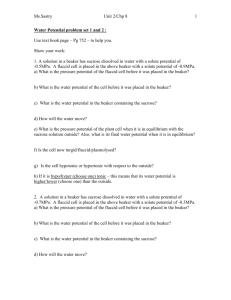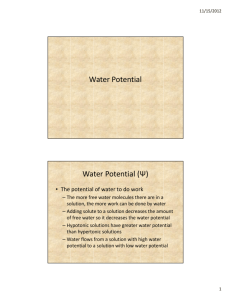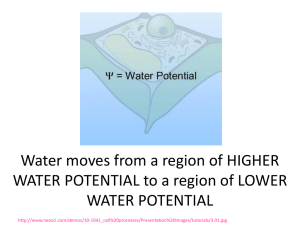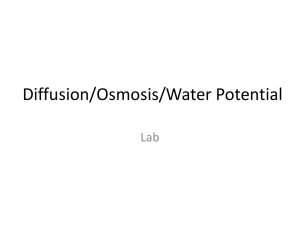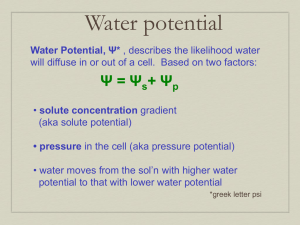Water Potential: Osmosis & Plant Cell Water Movement
advertisement
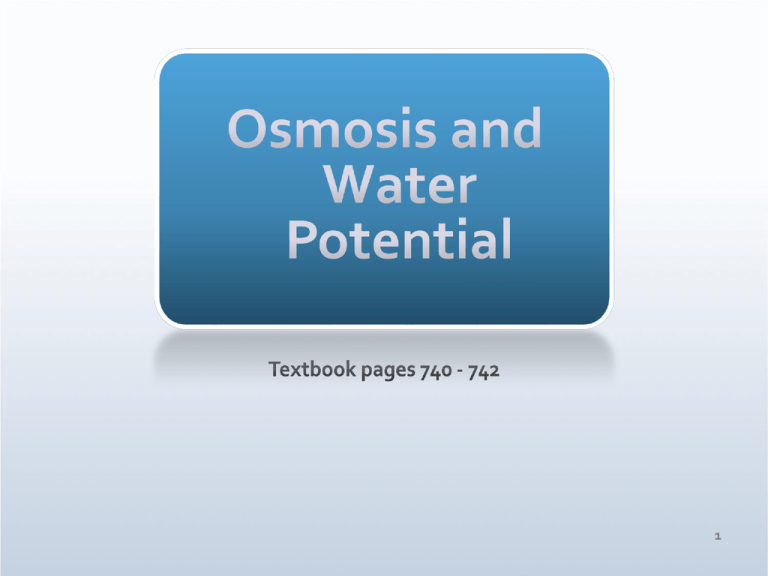
1 PROBLEM – What about physical pressure? physical pressure. It is easy to say that water will move from high concentration to low concentration…but look at the cell to the right…can the water keep going in? NO, as water enters and the cytoplasm begins to put pressure on the cell wall, the cell wall will begin push back (3rd law of motion) – physical pressure. The combined effects of solute concentrations and physical pressure are given in a single measurement called the WATER POTENTIAL (Ψ; psi) for a given solution (EACH SOLUTION IS ASSIGNED A WATER POTENTIAL). WATER POTENTIAL How is water potential calculated? physical pressure. Ψ = Ψs + Ψp Ψ = water potential of the given solution 1. The potential pressure, in Mpa, that the water will exert on another solution. 2. Water always move from solutions of higher water potential (higher pressure) to solutions of lower water (lower pressure) of course. 3. Water potential determines the direction of water movement 4. Largest water potential = 0 Mpa = DISTILLED WATER It has the greatest available free water molecules greatest potential to move and do work greatest pressure potential to exert on another solution WATER POTENTIAL physical pressure. How is water potential calculated? Ψ = Ψs + Ψp Ψ = water potential of the given solution Ψs = solute potential (osmotic potential) 1. Ψs = defined as 0 MPa for pure water; it becomes more and more negative as more and more solute is added since the potential pressure the water would exert on a neighboring solution should less if the water concentration is falling. 2. Always either zero or negative 3. Makes sense since the more solute, the more likely you are to bring water to you and therefore the lower the potential pressure exerted by the water. WATER POTENTIAL physical pressure. How is water potential calculated? Ψ = Ψs + Ψp Ψ = water potential of the given solution Ψs = solute potential (osmotic potential) Ψp = [physical] pressure potential 1. Ψp = potential pressure the water will apply on a neighboring solution due to physical forces 2. Ψp can be positive or negative since the physical pressure can be greater than atmospheric pressure (positive; i.e. in a turgid plant cell) or less than atmospheric pressure (negative; i.e. xylem cells when water is flowing through by transpiration). Quantitative analysis of WATER POTENTIAL Look at the four conditions on the right and explain what you are observing in terms of water potential. Water is moving from higher water potential to lower water potential whose values are dependent on solute potential and pressure potential. More solute - more negative Ψs More pressure - increases Ψp Less pressure - decreases Ψp Quantitative analysis of WATER POTENTIAL Look at the conditions on the right and explain what you are observing in terms of water potential. The cell is at equilibrium when the cell wall pushes back with the equivalent pressure potential of 0.7 MPa Quantitative analysis of WATER POTENTIAL 1. A solution in a beaker has sucrose dissolved in water with a solute potential of -0.5MPa. A flaccid cell is placed in the above beaker with a solute potential of -0.9MPa. a) What is the pressure potential of the flaccid cell before it was placed in the beaker? 0 MPa since the cell wall applied no pressure if flaccid b) What is the water potential of the cell before it was placed in the beaker? Ψs + Ψp = Ψ -0.9 + 0 = -0.9MPa c) What is the water potential in the beaker containing the sucrose? Ψs + Ψp = Ψ -0.5 + 0 = -0.5MPa d) How will the water move? From high to low water potential (from beaker to cell) e) What is the pressure potential of the plant cell when it is in equilibrium with the sucrose solution outside? Also, what is its final water potential when it is in equilibrium? Equilibrium tells you that the water potential of both solutions must be the same. If the outer solution is -0.5MPa then the cytoplasm must also be -0.5MPa. Ψ = Ψs + Ψp -0.5MPa = -0.9 MPa + Ψp Ψp = 0.4, a positive number makes sense since the cytoplasm’s potential to apply pressure is increased if the cell wall is pushing on it. f) Is the cell now turgid/flaccid/plasmolysed? turgid g) Is the cell hypotonic or hypertonic with respect to the outside? It is still hypertonic since not much water would have entered before pressurizing the cell causing the membrane to push back. Quantitative analysis of WATER POTENTIAL 2. A solution in a beaker has sucrose dissolved in water with a solute potential of -0.7MPa. A flaccid cell is placed in the above beaker with a solute potential of -0.3MPa. a) What is the pressure potential of the flaccid cell before it was placed in the beaker? 0 MPa since the cell wall applied no pressure if flaccid b) What is the water potential of the cell before it was placed in the beaker? Ψs + Ψp = Ψ -0.3 + 0 = -0.3MPa c) What is the water potential in the beaker containing the sucrose? Ψs + Ψp = Ψ d) How will the water move? -0.7 + 0 = -0.7MPa From high to low water potential (from the cell to the beaker) e) What is the pressure potential of the plant cell when it is in equilibrium with the sucrose solution outside? Think carefully – does the plant cell wall change shape? Ψp = 0, the plant cell wall is not exerting pressure on the cytoplasm since water is moving from the cell into the beaker f) Also, what is the cell’s final water potential when it is in equilibrium? Water potential of cell = water potential of beaker -0.7 MPa g) Is the cell now turgid/flaccid/plasmolysed? plasmolysed h) What is the cell’s solute potential when it is in equilibrium? Ψ = Ψs + Ψp -0.7MPa = -0.7 MPa + 0MPa Water potential of cell = water potential of beaker I) Is the cell hypotonic or hypertonic with respect to the outside? hypotonic J) If it is hypo/hyper (choose one) tonic – this means that its water potential is higher/lower (choose one) than the outside. hypotonic & higher Review Questions: Water will move out from hypo- to hypertonic The cell will crenate. Review Questions: The solution is hypertonic as the solute concentration is higher making the water concentration lower than inside the cell. Osmosis will take place since membrane is not permeable to sugar. Water will diffuse out of the cell causing it to crenate. -24.8 bars Ψs + Ψp = Ψ -24.8 bars + 0 = -24.8 bars -4.9 bars Into the cell: from high water potential to low water potential
